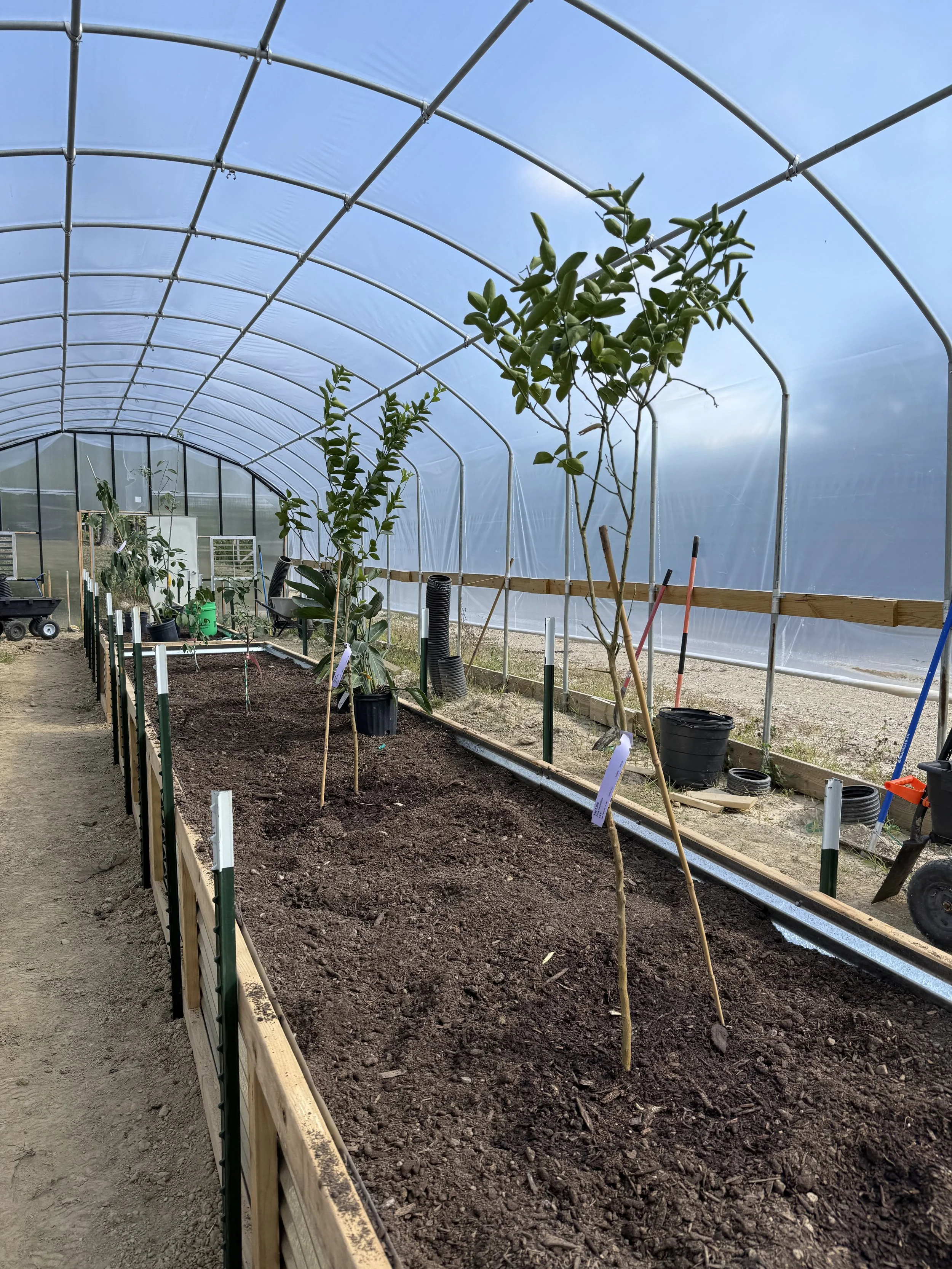SARE Grant Geothermal Greenhouse
We are excited to be constructing the first ground-to-air-heat-transfer system (GAHTs) greenhouse in our region.
Our farm is located in Miamisburg, Ohio
USDA Hardiness Zone 6b
SARE contract number: FNC25-1448
-
Ground-to-air-heat-transfer systems (GAHT) have been used in greenhouses in the Plains and the Northeast. However, these installations are deployed on super insulated structures. We believe GAHTs have the potential to heat inexpensive high tunnels to temperatures to support cold sensitive crops year round in Ohio.
-
A greenhouse climate battery is a geothermal system that uses the earth beneath a greenhouse as a thermal battery to store and retrieve heat. It circulates hot, moist air through a network of underground pipes during the day to store heat in the soil, and then draws cooler air through the pipes at night to pick up stored heat and warm the greenhouse. This helps regulate greenhouse temperature year-round by reducing heating costs and preventing overheating.
-
Ground-to-air-heat-transfer systems (GAHTs) have been used in greenhouses in the Plains and the Northeast. However, many of these installations have been deployed on super insulated greenhouse structures which are broadly cost prohibitive and prevent widespread technology deployment with commercial growers thereby limiting the technology to hobby or boutique applications.
Also, much of the research to date does not characterize or capture real-time data of GAHT performance which can aid in design optimization (see FNE20-962, FNE22-026, FNE20-948). These studies do not provide the necessary data to apply the learnings directly to other contexts. Often the results are constrained to the project’s own growing system (i.e. “this is how it worked for us on our farm this one time”). Though this is a useful contribution to the discussion, it leaves a gap in terms of understanding the fundamental capacity of such a technology to be deployed to aid commercial growers.
The unique innovation we will contribute is a data driven model of GAHT performance and the resultant impact on high tunnel conditions. If system characteristics can be monitored and understood, optimizations in design will make the deployment more affordable and enable more growers to benefit economically.
By characterizing the performance of the GAHT in real life, we believe the technology can successfully heat low cost high tunnels in our region and enable production year round of high value crops.
-
We have already completed advanced energy modeling and determined GAHTs have the potential to heat an inexpensive high tunnel to temperatures capable of supporting perennial tropicals and fruit producing vine crops year round in southwest Ohio (i.e. USDA hardiness zone 6b). Presently we have a high tunnel on the farm with a GAHT installed underneath. The GAHT is similar to Shannon Mutschelknaus’s design as described in FNC19-1185 and was used in our energy modeling.
Our objectives in this project are to (1) monitor the GAHT and resultant greenhouse performance in real-time to (2) capture the data necessary to inform improvements in design which (3) ultimately lower the cost of technology deployment for other farmers. This open source solution holds the potential to lower operating costs and increase crop production for vegetable, fruit and exotic plant production in our region.
This will be executed by (1) equipping our GAHT equipped high tunnel with temperature, relative humidity and soil moisture sensors as well as air speeds sensors and a weather station. The data gathered will be (2) published to a website in real-time for observation and analysis. The analyses will be (3) shared to public audiences via conference presentations and by hosting a field day. This detailed approach to data gathering will enable design decisions for farmers considering the technology on their own farms.
The GAHT installed under our high tunnel consists of several parallel pipes connected via an intake and outflow manifold. These GAHT assemblies are buried at depths of 2ft and 4ft, one directly below another. A total of 10 assemblies are in place (five at 2ft and five at 4ft) underneath our 20ft x 50ft high tunnel. The ducts which comprise the air distribution system of the GAHT consist of 6” plastic corrugated manifolds with 4” plastic corrugated pipe laterals with drainage holes.
Monitoring
Real-time continuously monitoring sensor will be installed as follows:
Temperature and relative humidity at the intake and outflow on two separate system at 2’ and 4’ depths
Temperature and soil moisture monitoring in earth to air heat exchanger storage area at 9 points at two depths (total of 18 points)
Monitor blower activity (two blowers) and in-pipe air speeds (two speeds recorded)
Status monitors on the ventilation systems (exhaust fan, roll up sidewalls) and the backup emergency heaters
A total of 52 parameters are to be measured plus a weather station
All sensors will be wi-fi enabled to allow each feed to be directly uploaded to the cloud. All data will be managed using the Adafruit IO platform. This platform will enable the creation of real-time public dashboards which can be shared via the web for anyone to review. Data is stored indefinitely on the platform which will enable the teams and others to review conditions and system performance.
The data will be used to examine the GAHT thermal capacity and performance characteristics. These analyses will use data from the 2025/2026 and 2026/2027 winters. This data set will expose seasonal variability of the GAHT and its ability to supply sufficient heat to the high tunnel. This portion of the analysis will enable our team to make recommendations regarding the required GAHT size for a high tunnel in our region.
View our monitoring systems in real time by clicking on these images.
What are we growing?
Key Lime
Meyer Lemon
Haas Avocado
Rainier Cherry
Bing Cherry
Current Plant List
Ginger
Turmeric
Figs
Tomatoes







